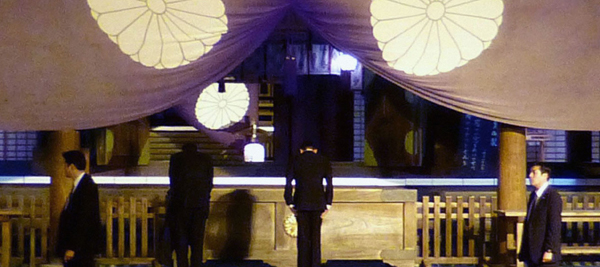A skewed view of history

The occupying U.S. Military Government had Tojo’s body cremated in Yokohama immediately after the execution and ordered the ashes scattered in the Pacific Ocean from a plane. The belief at the time was that remaining supporters may attempt to sanctify the remains.
And indeed, backers, including the defense counsel, colluded with the crematorium manager and managed to hide away some of the remains. A handful of ashes from each of the seven executed war criminals were put into a jar together. Since separating them would have been an impossible task at the time, the ashes were kept together.
The urn was hidden in the Koa Kannon Temple (dedicated to the bodhisattva of compassion) in the famous hot spring town of Atami until its existence was made public in 1958. Then, it was moved to Aichi Prefecture and buried at its current location. A memorial grave for Hideki Tojo also exists in Zoshigaya Cemetery in Tokyo, though the actual remains are not buried there. The situation in Japan is quite different from Germany, where it is hard to find any grave of executed Nazi war criminals.
But if you ask Japanese people where Tojo is buried, most of them would mistakenly say the Yasukuni Shrine. Tojo and other Class-A war criminals are enshrined in Yasukuni, which commemorates Japan’s 2.47 million war dead. But no remains or ashes are kept there. The shrine only has name plates of the dead. But Yasukuni enshrines those people as “gods.” In other words, Yasukuni is not a grave. Many Japanese consider it a national religious facility and memorial.
What about Germany, another defeated nation of World War II? Germans also have a memorial dedicated to the victims of war. The Neue Wache, or the New Guard House, is located in Berlin. During the division, it was in East Germany and was called the Memorial to the Victims of Fascism and Militarism. After reunification, the German government rededicated it in 1993 as the Central Memorial of the Federal Republic of Germany for the Victims of War and Dictatorship.
The ceremony for the people’s Mourning Day on the third Sunday of November is also held here. The public holiday commemorates many victims of war, including the soldiers who were drafted by the Nazi regime, civilians killed during armed conflicts, Jews and gypsies who died in concentration camps, and foreign nationals who fought against the Nazis.
While the German soldiers who were mobilized in the war of aggression are also mourned, neighboring countries do not protest it since they are defined as the victims of the war and the dictatorship. It is possible because they are considered separate from the Nazis and because Germans acknowledge that the war was evil and have pledged not to repeat it.
In this sense, Japan is far behind. Some still romanticize the country’s past aggression. They argue that a visit to Yasukuni belongs in the realm of religious freedom.
It is only just that those who sacrifice their lives for their country should be mourned. But an aggressor needs to care for the countries it invaded and persuade them on the universality of mourning, just as Germany did. Unfortunately, as long as the Yasukuni cult dominates the Japanese mentality and war criminals’ graves are cherished, it’s very hard to expect Japan to mourn as Germans do.
Talks on establishing a national mourning facility began more than a decade ago, but not much progress has been made. Of course, we understand how the surviving families of the Japanese war dead feel. They also suffered in the defeat. But they don’t yet seem to realize that the monster that dragged them into the hell of war was internally incubated militarism.
The Japanese government apologized for its colonial rule in the Murayama Statement in 1995. But once you make an apology, you need to consistently maintain that stance. We cannot but doubt their sincerity when their actions are not in line with the apology. Japanese cabinet members’ Yasukuni visits are nothing but a denial of their previous apologies. Is that how Japan really wants to behave?
*The author is an editorial writer of the JoongAng Ilbo.
by Nahm Yoon-ho










with the Korea JoongAng Daily
To write comments, please log in to one of the accounts.
Standards Board Policy (0/250자)